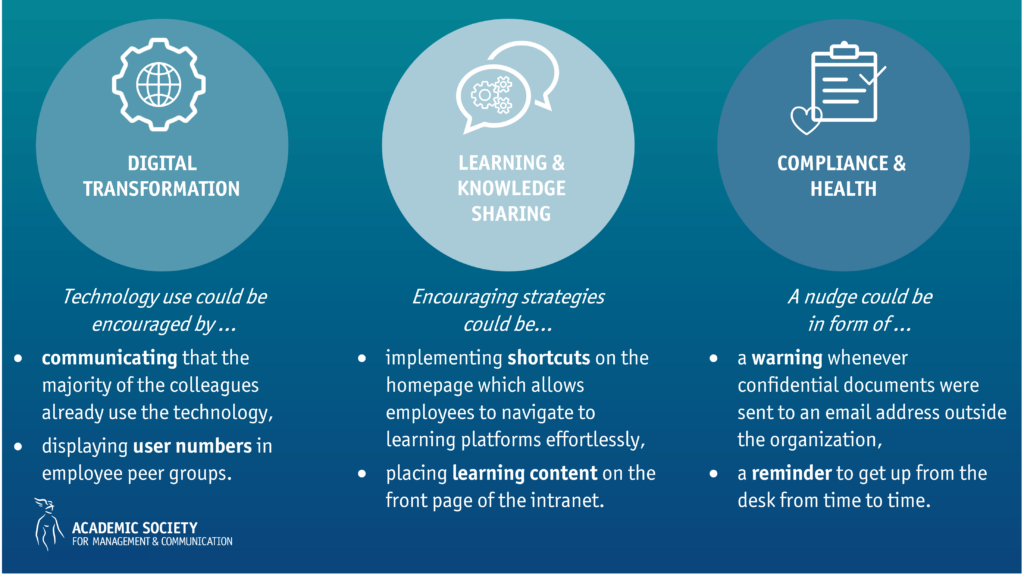© Rymden / stock.adobe.com
Why nudging matters for communication professionals
Using psychological insights to improve people’s decision-making is increasingly popular. But the concept of nudging – gently steering people to making better choices – has been rather under the radar for communications. The term has been brought into focus by University of Chicago economist Richard H. Thaler and Harvard Law School professor Cass R. Sunstein and has already been used in many contexts such as public policy and energy consumption behavior.
Implementing nudging can be a daunting task with technical and ethical challenges. Here are four reasons why it’s still useful for communication professionals to learn about it.
We are not homo oeconomicus
According to Nobel Prize laureate Daniel Kahneman, there are two systems of thinking. System 1 thinking is quick, automatic and draws on „mental shortcuts“ (heuristics, biases) and is highly context-dependent. This can sometimes lead to suboptimal behavior that is incongruent with an individual‘s goals or beliefs. System 2 is slow, deliberate and demanding – weighing pros and cons in a choice situation. Basically, we’re not always rational human beings constantly choosing the best possible way.
Think, for instance, about navigating through the potential massive number of emails in your inbox on a full working day – deciding within seconds if mails can be deleted, archived or answered. That’s most probably your System 1 working. An example of System 2 is writing an important email to the entire managing board to which you probably dedicate deep thinking. (Digital) nudges can address both thinking systems. Encouraging staff to be more aware of phishing if the sender of an email was unknown or a warning whenever confidential documents were sent to an email outside the organization can be typical nudge-like interventions supporting the daily decision-processes.
Work environments change faster than ever
Today’s fast-paced changes in the workplace particularly due to the digitalization or ongoing crises such as the COVID-19 pandemic requires communication professionals to communicate even more effectively. This is where digital nudging comes in. Specifically, a (digital) nudge is a user interface design element which steers behavior in a predictable way. A nudge is not a ban or an instruction but rather a warning or a guidance towards something we otherwise wouldn’t pay attention to.
There are several promising application areas for nudging in corporate communications, such as supporting the digital transformation, encouraging learning and development as well as knowledge sharing. Other areas can be increasing compliance behavior (especially regarding cybersecurity) or improving employees’ health and well-being.

CommTech is on the rise
Communication professionals use a variety of digital environments in their work and interaction with stakeholders, also called “CommTech”(Zerfass & Brockhaus, 2021). The design of these digital environments can influence the response of stakeholders and ultimately the effectiveness of communication initiatives. Seemingly small changes in the design of a user interface can influence how recipients behave and what decisions they take. For example, if an option is selected as a default, recipients are far more likely to choose it. Connecting scientific knowledge about human decision-making processes and interface design is the core of nudging.
The role of communication professionals includes being a consultant
The applicability of nudging hugely depends on whether the organization uses digital platforms that allow for customization and on whether a flexible corporate design exists which allows integrating digital nudges in existing toolboxes. If none of this applies but one consults other departments and stakeholders, learning about nudging might be relevant regardless of whether one can implement it oneself.
This not only applies for knowledge about potential nudging possibilities but also for knowledge about ethical challenges with nudging. While digital nudges are often used for pro-social goals or goals which are generally considered desirable, selecting these goals can be problematic and it should always be discussed whether it’s ethically and morally justifiable to influence recipients in one way or another.
Moreover, being aware of nudging effects could also help to avoid influencing decisions where it’s not wanted, for example when conducting employee surveys.

„I expect that some of the underlying ideas of nudging are already being used. However, they’re not based on scientific insights but on intuition and professional experience. Digital nudging would allow communications professionals to systematize their approach and could increase the success of communications.“
Thomas Mickeleit, Communications Consultant Digital Transformation, KommunikationNeuDenken!
About the study
These insights are based on a one-year research project conducted by Stefan Stieglitz and Sünje Clausen at the University of Potsdam. The project explored how digital nudging can help to guide individual decision-making and behavior in digital environments.